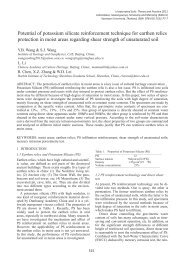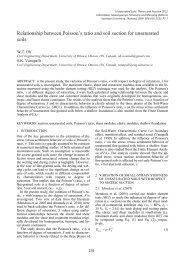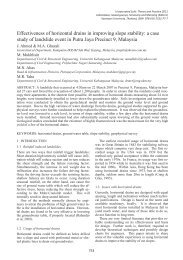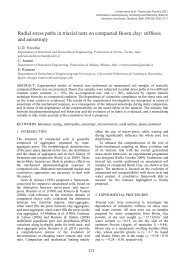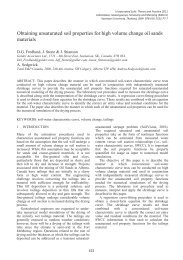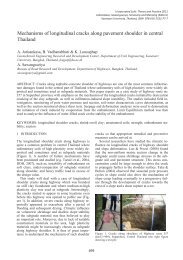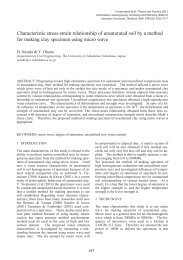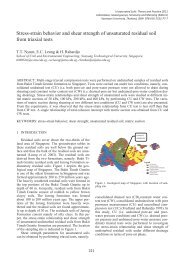Application of electrical resistivity method to detect deep cracks in ...
Application of electrical resistivity method to detect deep cracks in ...
Application of electrical resistivity method to detect deep cracks in ...
You also want an ePaper? Increase the reach of your titles
YUMPU automatically turns print PDFs into web optimized ePapers that Google loves.
Electrical Resistivity Tomography (ERT) provides<br />
an <strong>electrical</strong> image <strong>of</strong> subsurface soil and it<br />
can be used as an early <strong>detect</strong>ion <strong>of</strong> soil layers. Furthermore,<br />
the result <strong>of</strong> ERT can be correlated with<br />
soil strength that is derived from geotechnical data.<br />
However, as reported <strong>in</strong> literatures (Braga et al.,<br />
1999; Giao et al., 2003), there is poor relationship<br />
between <strong>resistivity</strong> parameter and N-value from<br />
SPT. To ga<strong>in</strong> better understand<strong>in</strong>g <strong>of</strong> the correlation,<br />
Sudha et al. (2009) used transverse <strong>resistivity</strong> that<br />
plotted with the N-value.<br />
This paper discusses the results <strong>of</strong> a soil <strong>in</strong>vestigation<br />
<strong>to</strong> <strong>detect</strong> <strong>deep</strong> <strong>cracks</strong> on unsaturated residual<br />
soil slopes <strong>in</strong> Jombok village, Ngantang city, Indonesia<br />
us<strong>in</strong>g an <strong>electrical</strong> <strong>resistivity</strong> <strong>to</strong>mography<br />
(ERT) <strong>method</strong> with two-array dipole-dipole and<br />
azimuthal array <strong>method</strong>. Subsequently, bore-hole<br />
and SPT data were used <strong>to</strong> verify the results <strong>of</strong> the<br />
results <strong>of</strong> ERT. The location <strong>of</strong> this study along with<br />
pr<strong>of</strong>ile l<strong>in</strong>e <strong>of</strong> ERT and po<strong>in</strong>ts <strong>of</strong> geotechnical <strong>in</strong>vestigations<br />
are shown <strong>in</strong> Figure 1. In addition, this paper<br />
also presents the correlation between measured<br />
SPT N-values and the <strong>resistivity</strong> <strong>of</strong> soil.<br />
Figure 1. Map <strong>of</strong> the study area show<strong>in</strong>g the dipole-dipole ERT pr<strong>of</strong>ile l<strong>in</strong>es, azimuthal array po<strong>in</strong>ts<br />
(A) and borehole locations (BH)<br />
2 SITE INVESTIGATION<br />
In order <strong>to</strong> obta<strong>in</strong> subsoil characteristics <strong>in</strong> the study<br />
area, three borehole tests were conducted at BH1,<br />
BH2, and BH3 as shown <strong>in</strong> Figure 1. At every 2m<br />
depth <strong>in</strong> each borehole, SPT test was performed follow<strong>in</strong>g<br />
the procedure <strong>of</strong> ASTM. The measured SPT<br />
N-values with the depth are shown <strong>in</strong> Figure 2.<br />
Ground water table (GWT) <strong>in</strong> three borehole locations<br />
are plotted <strong>in</strong> this Figure 2 as well. In general,<br />
the N-value <strong>in</strong>creases with depth. However, discrepancies<br />
<strong>of</strong> N-value were found at some locations. In<br />
BH1 and BH3, low SPT N-values (2 – 7) were recorded<br />
from 0 <strong>to</strong> 12 m depth.<br />
Soil samples collected at every 1m depth <strong>in</strong> each<br />
borehole were used <strong>to</strong> determ<strong>in</strong>e water content, specific<br />
gravity, atterberg limits, dry unit weight, gra<strong>in</strong><br />
size distribution, and shear strength us<strong>in</strong>g direct<br />
shear test <strong>in</strong> the labora<strong>to</strong>ry follow<strong>in</strong>g ASTM test<strong>in</strong>g<br />
procedures.<br />
Figure 2. Variation <strong>of</strong> measured SPT N-values with depth <strong>in</strong><br />
each borehole.<br />
902



